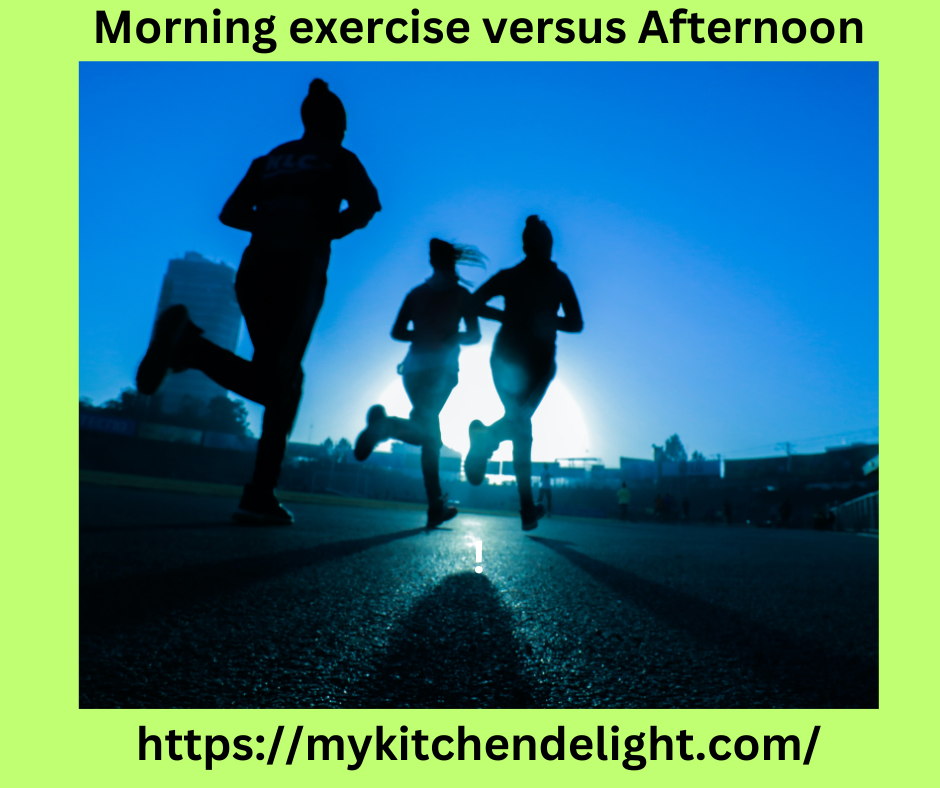
Difference between Morning exercise versus Afternoon
Morning exercise and afternoon exercise both offer a range of benefits. The choice of when to exercise may depend on personal preference, schedule, and physical goals. In this article, we will explore the differences between morning and afternoon exercise and discuss the potential advantages and disadvantages of each.
Physical performance
Morning exercise can help to kickstart the metabolism and increase energy levels for the day ahead. Studies have found that exercising in the morning can improve physical performance later in the day. This is because morning exercise can help to improve blood flow, warm up the muscles, and increase oxygen supply to the body.
In contrast, afternoon exercise may be more beneficial for those who are looking to achieve their maximum physical potential. This is because the body temperature tends to be at its highest in the afternoon, which can help to increase muscle strength and power. Additionally, the body has had time to fully wake up and become more alert, which can help to improve focus and concentration during a workout.
Hormonal changes
Exercise can cause changes in hormone levels, which can impact physical performance and energy levels. Hormone levels can vary depending on the time of day, which may impact the benefits of morning vs. afternoon exercise.
For example, testosterone levels tend to be higher in the morning, which can help to improve muscle growth and strength. Cortisol levels, which can impact stress and energy levels, tend to be lower in the morning and higher in the afternoon.
Mood and motivation
The time of day that you choose to exercise may also impact your mood and motivation. Morning exercise can help to improve mood and increase energy levels for the day ahead. Additionally, starting the day with exercise can create a sense of accomplishment and provide a positive start to the day.
On the other hand, some people may find it easier to get motivated for an afternoon workout. This may be because the body has had time to fully wake up and become more alert, or because they prefer to use exercise as a way to destress after a busy day.
Time and schedule
One of the most significant factors in deciding whether to exercise in the morning or afternoon is schedule and availability. Many people find that exercising in the morning is easier to fit into their schedule, as they are less likely to have conflicts or other commitments at that time. Additionally, exercising in the morning can help to set a positive tone for the day ahead.
However, others may prefer to exercise in the afternoon, as they may have more energy or feel more alert at that time. Additionally, for those who work long hours, an afternoon workout can be a good way to relieve stress and increase energy levels after a busy day.
Sleep Quality
Exercise can impact sleep quality, which may be an important consideration for those who choose to exercise in the morning or afternoon. Some studies have found that morning exercise can help to improve sleep quality, as it can help to regulate the body’s natural sleep-wake cycle. Additionally, morning exercise can help to reduce stress levels, which can also improve sleep quality.
On the other hand, some people may find that afternoon exercise disrupts their sleep patterns, as the increased energy and alertness may make it harder to wind down at night. Additionally, exercising too close to bedtime can increase heart rate and body temperature, which can also make it harder to fall asleep.
Environmental factors
Environmental factors can also impact the benefits of morning vs. afternoon exercise. For example, during the summer months, exercising in the morning may be more comfortable, as the temperatures tend to be cooler. In contrast, during the winter months, some people may find it easier to exercise in the afternoon, as the temperatures may be warmer at that time.
Additionally, those who prefer outdoor exercise may find that the time of day impacts their ability to exercise.

Here are some examples:
Running: Those who prefer to go for a morning run may find that the cooler temperatures and peaceful surroundings help them to start their day off on a positive note. In contrast, those who prefer to run in the afternoon may enjoy higher energy levels and warmer temperatures, which can help to improve physical performance.
1-Cycling: Similar to running, those who prefer to cycle in the morning may enjoy cooler temperatures and quieter roads. In contrast, those who prefer to cycle in the afternoon may enjoy the warmer temperatures and more social atmosphere, as more people may be out and about at that time.
2-Yoga: Some people may prefer to start their day with a morning yoga practice, as it can help to improve focus and concentration for the day ahead. Others may prefer to do yoga in the afternoon or evening, as it can help to relieve stress and tension after a busy day.
3-Swimming: For those who prefer outdoor swimming, the time of day may impact the temperature of the water. In the morning, the water may be cooler and more refreshing, while in the afternoon, the water may be warmer and more comfortable.
4-Hiking: Some people may prefer to go for a morning hike to enjoy the peaceful surroundings and cooler temperatures. Others may prefer to hike in the afternoon to take advantage of the warmer temperatures and longer daylight hours.
These are just a few examples, but there are many other types of outdoor exercise that may be impacted by the time of day. Ultimately, the choice of when to exercise may depend on personal preference, schedule, and physical goals. It’s important to choose a time that works best for you and your lifestyle and to make exercise a consistent part of your daily routine.

